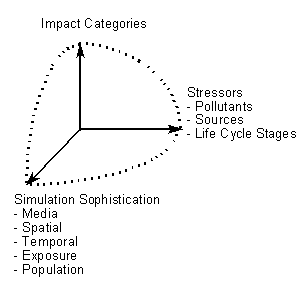|
(American Institute of Chemical Engineers) Miami, FL, November 15 - 20, 1998 |
||
|
.
Jane C. Bare & David W. Pennington
TRACI is a state-of-the-art impact assessment tool for the implementation of P2, LCA, and Sustainability Programs, allowing the assessment of chemical impacts in the following impact categories: ozone depletion, global warming, photochemical oxidation, eutrophication, acidification, human and environmental health effects. One key feature of TRACI is the development of a probabilistic impact assessment framework. |
||
|
BACKGROUND
 Environmental decision making for programs in pollution prevention (P2), life cycle assessment (LCA), and sustainable development requires comprehensive impact assessments which allow decision makers to incorporate a wider range of impact categories, pollutants, sources, and life cycle stages. Ideally an impact assessment should be comprehensive and sophisticated in all dimensions (shown in three dimensions by the dotted lines in the figure). In reality, every study is limited in resources, and it follows that every study must also be limited in some dimensions. Conducting the appropriate level of sophistication and comprehensiveness for each impact assessment is key to effective environmental decision making. If too complex a methodology is selected or the boundaries are too broad, the limited resources will prohibit completion of the study. If a narrow and/or too simplistic framework is defined, the assessment can lead to incorrect decisions, either by relying on gross and inaccurate modeling and data assumptions (leading to large uncertainties), or by failing to address the important factors relating impact to stressors. DESCRIPTION To assist in the decision making process for implementation of P2 or sustainability programs.TRACI has been structured to allow the assessment of chemical emissions which could have an effect on the above listed impact categories. Two of these impact categories - stratospheric ozone depletion and global warming - have scientific and International consensus on methodologies for the calculation of chemical impacts. Both of these impact categories are global, and are not strongly dependent on the temporal and spatial issues surrounding the chemical emissions. Five of these impact categories are dependent on the temporal and spatial characteristics of the release. For these categories, assessments are being carried out at different spatial and temporal scales using a tiered approach so that the impact of scale is part of the assessment. Assessments use both region-specific and U.S. average landscape/exposure properties. A probabilistic approach that allows the explicit treatment of uncertainty and variability defines how regional variability and parameter uncertainty impact the assessment outcome. Impact assessments allowing more specific scenario differentiation (e.g., geographic region, seasonal timing, urban vs. rural emissions) will reflect the increased level of certainty in the analyses. Dr. Gregory Norris, of Sylvatica, is reviewing recent and current scientific, modeling, and monitoring advancements in the U.S. and internationally which address eutrophication, acidification, and photochemical oxidation. Applicable databases linking emissions to effects, incorporating the influence of location and source characteristics will be used to develop several equivalency factors representing types of location (e.g., geographic region of the country; urban vs. rural) and seasonal timing. An International Workshop of impact category experts will be held to review and refine these methodologies during the summer of 1998. The U.S. EPA is working with the University of California, Berkeley, School of Public Health, under the direction of Dr. Thomas McKone, to accomplish the development of the impact assessment methodologies of the human and environmental health effects impact categories. Assessments for these categories will be developed using selected parameters chosen to represent the geographic and climate diversity of the U.S. incorporated into the CALTOX model. CALTOX, developed by Dr. McKone, uses a multimedia modeling framework allowing the assessment of various scenarios for human exposure, and has been described by the Science Advisory Board as potentially the most advanced of all of the (human health exposure) models reviewed. Future versions of TRACI will allow the sophisticated calculation of a new impact category - environmental health effects. Environmental health effects will be a toxicity based impact category calculated with exposure modeling of various plant and animal species including the bioaccumulation of substances through food chains. Again, probabilistic assessment will better convey to decision makers the capabilities and limitations of these calculations. Impact assessment methodology and equivalency factor development is expected to be completed near the end of 1998, followed by beta testing of TRACI. For further information about this, and other research conducted within the Impact Assessment and Measurement Team at the National Risk Management Research Laboratory, contact the Team Leader, Jane Bare, at Email: bare.jane@epamail.epa.gov
|





